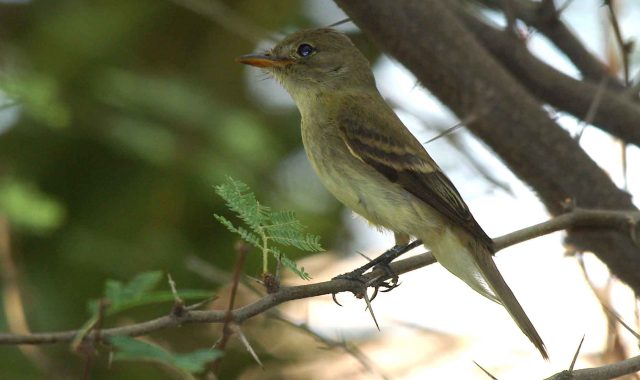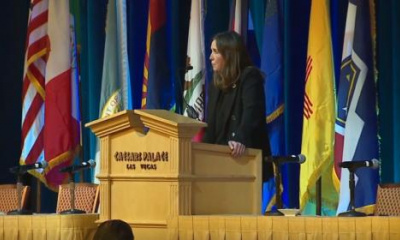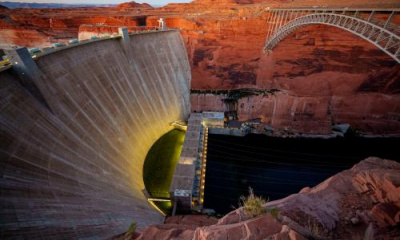ST. GEORGE — Tamarisk are highly flammable trees that can increase flood risk and soil salinity along the Virgin River and throughout the Colorado River Basin, but an endangered bird species taking up roost in its branches has complicated management of this otherwise destructive, invasive species.
Tamarisk, native to Eurasia and Africa, was introduced to the U.S. in the 1800s to control Dust Bowl-related erosion. Since then, it has spread across North America and the West, growing in watersheds throughout the Colorado River Basin. The trees, also known as salt cedar, are hardy and can grow in unexpected places.
Steve Meismer, a local coordinator with the Virgin River Program at the Washington County Water Conservancy District, told St. George News about myriad problems faced by wetland ecology when tamarisk take root.
“It’s kind of like the cockroach of the plant world in many respects because it has that ability to just grab hold and grow in many different places. … I’ve literally seen tamarisk — 2 feet tall — growing in the gutters on St. George Boulevard,” Meismer said.
Salt cedars can outcompete local species like willows and cottonwoods. Their long taproots allow them to access water deeper underground than many native trees. And, while individual plants use about as much water as native trees, on an “area-by-area basis,” tamarisk uses more water as a species, Meismer said.
Tamarisk also secrete salt, raising the surrounding soil’s overall salinity.
“That’s a competitive advantage for them because they make the ground around them so salty that nothing else can grow,” Meismer said, adding that necessary soil preparation for habitat restoration can be costly and work-intensive. So, often, land stewards need to wait for natural processes, like rain, to reduce salinity over time.
Still, with rain comes flood risk, and Meismer said salt cedars can worsen these situations. The rigid trees don’t bend under the force of floodwaters like willows, instead collecting debris and slowing flows. The trees reportedly played a role in the severity of the 2005 Santa Clara River floods.
“(Debris) piled up on that stiff, woody vegetation, basically like a picket fence across the river,” he said, adding that the water followed the “easier path of resistance” under nearby homes.
Tamarisk can also alter natural stream flows, said Christian Edwards, a native aquatics biologist with the Division of Wildlife Resources’ Washington County Field Office. Water tends to move around tamarisk stands, channelizing rivers that would otherwise meander. At the same time, sediment forms steep banks, increasing the river’s velocity.
This can be harmful to the endangered and sensitive fish species that occupy the river, such as woundfins, Virgin River chubs, Virgin spinedaces, flannelmouth suckers, desert suckers and speckled daces, Edwards said.
The fish require access to slower-moving, deeper pools where they can spawn and lay their eggs and for young fish to grow. Edwards said these fish may have difficulty finding cover in fast-moving, channelized rivers.
Additionally, the trees burn “extremely well,” even when green, partly due to the oils they produce, Meismer said.
“If you’ve ever seen a tamarisk fire, it is a conflagration that you don’t want to see and you don’t want to be close to because it is very, very violent and very, very hot,” he said.
Providing cover for endangered birds
Not everyone hates salt cedar trees; in fact, one endangered bird appears to prefer them, Edwards said.

A Southwestern willow flycatcher perches on a tree, location and date not specified | Photo courtesy of the U.S. Fish and Wildlife Service, St. George News
Southwestern willow flycatchers are small birds best known for their calls, including a “sneezy witch-pew or fitz-bew,” according to the U.S. Fish and Wildlife Service. The birds were federally listed as endangered in 1995, facing various risk factors, including loss or degradation of their habitat, fire and human disturbances.
While flycatchers are known to build nests in native vegetation, like coyote willows, they often prefer tamarisk because the invasive trees are “structurally complex,” Edwards said.
The trees have many branches and catch debris, like cottonwood or willow fluff, which “makes for a good tree to build a nest” as dense, “messy” tamarisks can conceal flycatchers from predators. Over the last 17 years the DWR has been monitoring the species, Edwards said, adding that approximately 75% of nests have been found in salt cedars.
“That changes from year to year, but that’s the issue, is endangered Southwestern willow flycatcher likes to nest in tamarisk — this invasive weed that everybody wants to get rid of,” he said.
This serves as an obstacle to land stewards’ efforts to remove the invasive plants and restore native vegetation. But Meismer said restoration efforts are also typically restricted to the fall and winter after the breeding season has ended, and the bird is very “home-range oriented,” returning to the same nesting sites repeatedly.
The DWR conducts regular surveys, allowing agencies to pinpoint areas that should be avoided before launching a tamarisk-removal project, Edwards said.
Meismer added: “We don’t want to pull out all the tamarisk at once because it does have some habitat benefits to us, but it’s a challenge to try to work with it.”
Still, salt cedar does not appear to benefit other bird species as tamarisk-heavy areas are typically hotter and have a lower relative humidity, Edwards said.
“Native stands of plant vegetation are more suitable for wildlife in general,” he said, adding that while a handful of other birds will nest in the trees, they’re generally not “good for anybody,” except willow flycatchers.
Biocontrol
In the early aughts, the U.S. Department of Agriculture approved the release of tamarisk leaf beetles — a biocontrol method to reduce the trees’ numbers, using its “natural enemies,” according to the National Park Service. The beetles target salt cedars specifically, defoliating them by feeding on their leaves.
“Each repeated defoliation should result in a decrease or dying off of some of the root mass,” the service states. “Which if regularly repeated could kill tamarisk.”

A tamarisk leaf beetle feeds on a tamarisk tree, location and date not specified | Photo courtesy of the U.S. Department of Agriculture/Bob Richard, St. George News
Meismer said the beetles have helped to control tamarisk in Southern Utah.
“It’d be really pretty and green, and then the beetles would eat the leaves off of the tamarisk and that would turn them brown,” he said. “So whole swathes of area just go brown in the middle of the summer. It really showed how much tamarisk was there.
“If you go and you look at some of those areas today, they’re green all summer long because the native species have come in and gotten a foothold and done better as far as competing with the tamarisk. We’ve given them a little bit of an edge, and they’ve taken off.”
However, the beetles’ success can be a double-edged sword for flycatchers. In the fall, the beetles begin to hibernate and emerge again each spring. Meismer said flycatchers may build their nests in green tamarisk, concealed from the sun and predators before the beetles surface and defoliate the tree.
Then, the nest is exposed, making it an easier target for predators and more likely to overheat.
Audubon Southwest reported that in 2009, the beetles began feeding at the beginning of the birds’ nesting season, resulting in 87% — 13 of 15 — of the nests in St. George failing.
“This has been described by the (U.S. Geological Survey) as a possible ecological trap, wherein the habitat initially appears green and inviting to nesting birds only to change vegetation characteristics in the middle of the nesting season,” the organization states.








